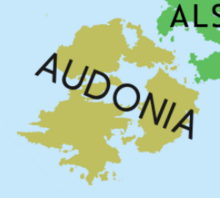Audonia
This article is a work-in-progress because it is incomplete and pending further input from an author. Note: The contents of this article are not considered canonical and may be inaccurate. Please comment on this article's talk page to share your input, comments and questions. |
Audonia is a continent. It is known as the heartland of Islamic civilization. It is comprised of three major areas, sometimes referred to as subcontinents.
 | |
| Area | 1,265,709 km2 (488,693 sq mi) |
|---|---|
| Population | 2,856,697,318 (2028)wip |
| Population density | 2,426/km2 (3,904/sq mi)wip |
| Demonym | Audonian |
| Countries | 27 |
| Dependencies | 3 |
| Languages | Arabic, Pukhtu, Burgoignesc, and others |
| Time zones | UTC-3:00 to UTC+2:00 |
| Largest cities | Largest urban areas: Peshawar Amenhotep Matsova |
Name
Audonia takes its present name in most Occidental languages from the Oduniyyad Caliphate.
Physical Geography
Siphost
The northern island of Audonia.
Daria
The southeastern island of Audonia.
Daria is considered to be a melting pot of influences from the rest of Audonia and Alshar, with which it shares much of its history and some of its culture.
XXX
The southwestern island of Audonia.
This subcontinent is closely associated with Islam, as the two holiest cities in that religion - as well as its historical heartland - exist here. Consequently, most of the nations on this subcontinent are large Muslim majority countries. Audonian Christianity also originated here with a minority of countries having bare Christian majorities, though most countries have at least a pre-Islamic Audonian Christian heritage.
Political Geography
Countries
Dependencies
History
The Audonian Golden Age was an era of unprecedented cultural and scientific flourishing in Audonia.
Audonia spent much of the Age of the Sail as the object of commercial and imperial competition between Burgundie and Kiravia, in which Burgundie ultimately prevailed.